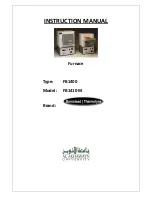
1083294-UIM-C-0615
14
Johnson Controls Unitary Products
CONTROL WIRING USING COMMUNICATING
CONTROLS
Use the wiring diagram above to connect the furnace control, Commu-
nicating Control (wall thermostat) and communicating outdoor unit. Be
sure that all of the “A” terminals are connected together, all of the “B”
terminals are connected together, all of the “GND” or “C” terminals are
connected together and all of the “R” terminals are connected together.
See Figure 19. When using a fully communicating system, the large
screw terminals (C, G, R, etc.) on the furnace control are not used. The
four small screw terminals in the terminal block on the end of the fur-
nace control should be used.
Float Switch Input
An optional switch may be connected to the FLT SWT terminals on the
control board. This feature is only functional when used with the Com-
municating Control. It is intended for use with a water overflow switch
that has contacts in either the normally open (NO) or (NC) position.
Auxiliary Switch Input
An optional switch may be connected to the AUX SWT terminals on the
control board. This feature is only functional when used with the Com-
munication Control. Refer to Communication Control Installation Man-
ual.
LOW VOLTAGE CONTROL WIRING CONNECTIONS
Install the field-supplied thermostat by following the instructions that
come with the thermostat. With the thermostat set in the OFF position
and the main electrical source disconnected, connect the thermostat
wiring from the wiring connections on the thermostat to the terminal
board on the ignition module, as shown in Figures 21 - 24. Electronic
thermostats may require the common wire to be connected. Apply
strain relief to thermostat wires passing through cabinet. If air condition-
ing equipment is installed, use thermostat wiring to connect the Y and C
terminals on the furnace control board to the proper wires on the con-
densing unit (unit outside).
The 24-volt, 40 VA transformer is sized for the furnace components
only, and should not be connected to power auxiliary devices such as
humidifiers, air cleaners, etc. The transformer may provide power for an
air conditioning unit contactor.
FIGURE 19:
Two-stage Furnace with Communicating AC or HP
IMPORTANT
Do not place more than one wire under any single communication
terminal screw (there are four communication terminal screws). If
more than one wire must be connected to a terminal screw, attach
only the terminal end of a one wire pigtail no longer than 6“, and
use a wire connector to connect the other end of the pigtail to the
other wires. Failure to do this will result in nuisance communication
error faults. See Figure 20.
A+
R
C
B-
A+
R
C
B-
A+
R
GND
B-
O
DHUM
Y1
Y/Y2
W2
R
G
C
Touch Screen
Communicating control
Furnace
Communicating control
Air Conditioner/Heat Pump
Communicating control
W/W1
FIGURE 20:
Terminal Screw Wire Connection
IMPORTANT
Set the heat anticipator in the room thermostat to 0.4 amps. Setting it
lower will cause short cycles. Setting it higher will cause the room
temperature to exceed the set points.
IMPORTANT
Some electronic thermostats do not have adjustable heat anticipa-
tors. They should be set to six cycles per hour. Follow the thermostat
manufacturer's instructions.
W
I
RE
CO
NN
ECTOR
THERMOSTAT
OUTDOOR
U
NI
T
A+
R
C
B-
TERM
IN
A
L
SCREW
IN
DOOR
U
NI
T
NOTE
E
N
SURE
O
NL
Y O
N
E
W
I
RE
U
N
DER
TERM
IN
A
L
SCREW
.
TO
CO
NN
ECT MORE THA
N
O
N
E
W
I
RE
:
1
.
CO
NN
ECT O
NL
Y TERM
IN
A
L
E
N
D
OF
6”
W
I
RE
P
I
GTA
IL.
2
.
USE
W
I
RE
CO
NN
ECTOR TO
CO
NN
ECT
OTHER
E
N
D
OF
P
I
GTA
IL
TO
OTHER
W
I
RES
.
A
0
2
36
-
00
1
MODU
L
AT
IN
G
FUR
N
ACE
COMMU
NI
CAT
IN
G
CO
N
TRO
L













































